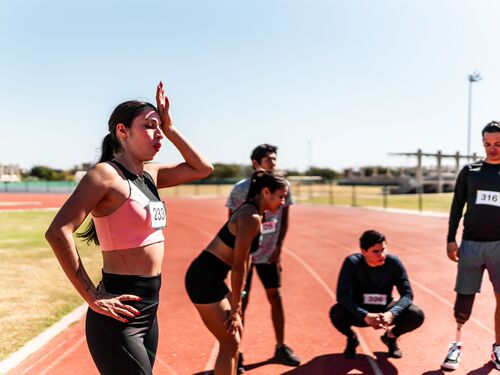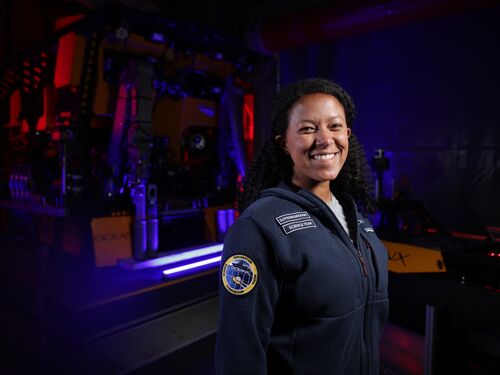The Future of Sports: Protecting Athletes Amid New Climate Realities
Program News
By Nikita Uberoi
Last update October, 25 2024
Tired young athlete woman taking a break after running on the sports track
As climate change intensifies, its impacts are felt in every aspect of our lives. The sports arena is no exception. Extreme weather events are not only reshaping landscapes, but also our daily lives and the activities we participate in. With millions of people engaged in sports and physical activity around the world, understanding the impacts that climate change is having on athletic communities is critical.
In a post-Olympics Climate Conversation this August, former elite marathoner, Tina Muir, moderated a discussion with sports ecologists Dr. Madeleine Orr (University of Toronto) and Dr. Jessica Murfree (University of North Carolina at Chapel Hill) to unpack exactly what implications climate change poses for sports. The conversation delved into the health and equity challenges athletes face, and discussed proactive measures that organizations and individuals can take to safeguard athletes from dangerous and, at times, life threatening environmental conditions.
SPORTS ECOLOGY: an area of research that studies sports, the natural environment, and the relationships between the two, to promote the sustainability and safety of sports.Climate Risks in Sports
During the 2024 Paris Olympics, climate change manifested in more ways than just sweltering competition days. In fact, Dr. Orr, who was on the ground, noted that heavy rains and elevated temperatures created the optimal conditions for E. coli to multiply in the Seine River, which compromised the water quality for swimmers competing in the Olympic triathlon.
The recent 2024 U.S. Open Tennis Championships in New York City also navigated their own climate challenges. Temperatures soared so high that athletes and fans suffered from heat-related illnesses during matches. This led the tournament organizers to enact an extreme heat rule, allowing for a 10-minute break between sets once the Wet Bulb Globe Temperature (WBGT), a measurement for heat stress, reached 30.1 degrees Celsius.
However, the implications of climate change on sports extends much farther than Paris or New York. Dr. Orr relayed some of the impacts she has seen in her decade long global research in sports ecology. For example, the loss of natural snow on ski slopes, water sport athletes getting rashes from algae blooms, and high school football seasons getting shut down in the West because of disastrous wildfires and poor air quality. In one case, a Pakistani football team experienced devastating floods followed by recurring heat waves, which not only destabilized playing surfaces but also resulted in disrupted sleep and mental health impacts for the athletes, all of which can decrease athletic performance.
With the rise in frequency and intensity of natural disasters, an emerging concern is that by 2030, up to 20% of Olympic nations may struggle to field teams due to climate-related disruptions and compounding effects. As Dr. Orr remarked, “in sport, if we continue to want to say you're the best in the world, we need the whole world there to say that.” Realities such as these underscore the need for collaboration among sports organizations, coaches, health officials, weather forecasters, and climate experts to develop effective adaptation strategies.
Health and Equity Challenges
While there are many climate concerns for athletes, heat-related illnesses, such as heat exhaustion and heat stroke, are the most life threatening. At the elite and professional level, athletes with access to the best resources are still suffering from heat stress, proving it’s not always about better fitness, grit and perseverance. Dr. Murfree and Dr. Orr both explained that with heat exposure, it is important to recognize the two sources of heat that athletes experience, ambient heat and exertional heat, which when combined are extremely dangerous for athletes.
Devastating heat illnesses are even more prevalent for youth and high school athletes. In fact, Dr. Murfree identified that student athletes have the highest level of participation yet the least amount of access to resources and attention, making them one of the most vulnerable populations to heat exposure. Moreover, heat related illnesses are not the only thing young athletes have to worry about. According to Dr. Murfree, rising temperatures are also associated with increases in vector-borne diseases, physical harms like sunburn, psychological and performance impacts, and dehydration.
Infrastructure and equipment choices also play a role in exacerbating heat impacts. For example, a decision such as using artificial turf can increase the temperature by tens of degrees more than natural grass. Dr. Murfree explained that younger bodies are also in closer proximity to that heating source, which increases the intensity of heat exposure. This puts young athletes, cheerleaders, players in the marching band, and spectators at a greater risk of heat illness. Although there are some holistic approaches that schools can take to mitigate these impacts, such as changes to training times and moving to indoor play, they are constrained by school schedules and resources. As Muir concisely said, “there are many variables coming together that are putting these kids at risk.”
Adding another layer to this issue, climate change disproportionately impacts vulnerable communities, exacerbating existing disparities in access to and participation in sports. As Dr. Murfree pointed out, the cost of engaging in sports is rising, and environmental challenges are making it even more difficult for underserved populations to participate. For example, areas with less shade and green space put populations at a higher risk to extreme heat exposure, especially with outdoor sports like running, football, and soccer. As climate-related challenges escalate, marginalized populations will continue to face barriers to participation, making it difficult to improve access and opportunities in sports.
Policies, Education, and Tools
Many heat-related incidents are preventable as long as we have the right measures in place. In addressing the climate, health, and equity challenges the sports world faces, we also need a clear understanding of who is responsible for making the decisions that can protect athletes of all levels from these risks. For example, the U.S. Occupational Safety and Hazard Administration (OSHA) recently proposed regulations to protect workers from extreme heat. However, as Dr. Orr remarked, athletes are an exempt group from the policy, which raises the question for paid athletes of who is protecting them.
Dr. Orr explained that the responsibility falls on teams, leagues, federations, and organizing committees to make decisions for athlete safety. Although there are determined parameters for air quality and extreme heat, there are no set standards, and these can differ from sport to sport. This makes widespread recommendations challenging, and often leaves it to individual organizations to create their own standards and policies.
It’s no surprise that at the elite level, we are starting to see adaptations for extreme weather, including the use of cooling tubs, technologies for body temperature monitoring, changes to schedules for athletes, and policies for heat breaks during games. However, these protections and policies must be adopted across the board, and at the collegiate and youth levels as well, Dr. Orr noted.
According to Dr. Murfree, the sports industry has been very reactive to date. The increasing number of high school football player fatalities from extreme heat has created a need for policy-based changes that can help administrators make decisions in the best interest of their athletes. Policies can allow for a more proactive and consistent approach, such as improved standards for heat and dedicated athletic training staff, that are needed to prioritize athlete safety and well-being over financial considerations.
The good news is that progress is being made, with more than 30 out of 50 states having heat-related policies for high school students. However, there is more work to be done. At both the collegiate and elite levels, the National Collegiate Athletic Association (NCAA) and the International Sports Federations have guidelines but no requirements. This leaves it to the discretion of individual associations, tournaments, and coaches to make their own policies and decisions for extreme weather conditions, and for individuals who are active to educate themselves.
“At the end of the day,” Dr. Murfree shared, “what is more expensive, adapting sport or recovering from loss of life or lack of participation in sport?”
As we look ahead, climate change will continue to threaten sports, and there is a growing concern about suitable environmental conditions for the 2028 Olympics in Los Angeles. The Climate Conversation in August demonstrated that the intersection of sports and climate change warrants immediate dialogue to develop strategies, adaptations, and better policies to protect all athletes, and especially the least resourced and most vulnerable. Ultimately, one of the most effective adaptations is reducing emissions, and the sports industry itself must consider ways to reduce its carbon footprint. Whether you partake in recreational exercise or sports, are an aspiring elite athlete or parent a child in sports, there are measures you can take to adapt to current and future climate related-disruptions and stay safe while enjoying the activities you love.
Watch the full conversation here.
Nikita Uberoi
Program Coordinator, Climate Crossroads
Former Professional Tennis Player




